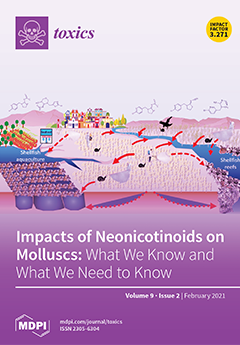The integrated use of plant-derived volatile attractants and synthetic insecticides in attract-and-kill programs is a useful tool for integrated pest management programs reducing pesticide input. Efficient alternative insecticides are critically needed to replace methomyl, which has been banned on cruciferous vegetables in China because it is also highly toxic to nontarget organisms. In the present study, among 15 commonly used insecticides were screened for toxicity against
S. litura moths, where chlorantraniliprole, flubendiamide, and emamectin benzoate was found to have the highest levels of toxicity (LC
50 of 0.56, 3.85, and 6.03 mg a.i. L
−1 respectively). After exposure to the low lethal concentration LC
50 of chlorantraniliprole, fecundity of the moths was substantially reduced. Egg-hatching was lower for LC
20- and LC
50-treated moth pairs than for untreated control pairs. Net reproductive rate (
R0), intrinsic rate of increase (
r), and finite rate of increase (
λ) were significantly reduced in LC
50♀ × LC
50♂ cohorts. Larval mortality was significantly higher in subsequent generations in pairs of LC
50-treated moths. Chlorantraniliprole, which was most toxic and had significant sublethal effects on moths, can be used as an alternative insecticide to methomyl in the attracticide for controlling
S. litura moths, and the LC
50 indicated a high potential for efficacy in the control
S. litura through attract-and-kill schemes.
Full article






